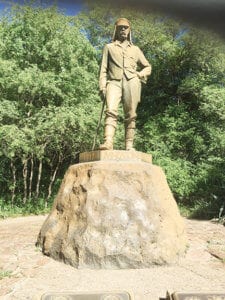By Sandra Long Weaver
Tribune Editorial Director
Part III of a III Part Series
VICTORIA FALLS, ZIMBABWE — -It is easy to see why Victoria Falls is one of the seven wonders of the world. It is breathtaking and incredibly beautiful.
Having the Falls included in the two-week tour was one of the reasons for selecting this trip from Gate1 Travel Agency. We spent our last two nights of the tour in the luxurious Victoria Falls Safari Lodge, about 20 minutes away.
We spent one night watching the sun set while cruising on the Zambezi River. The weather was ideal. And there were hippos, crocodiles and native birds all along the river. As the sun set, we watched the moon rise. A perfect night in Africa.
The next morning we headed to the Falls. As we drove through the town, it was a little jarring to see the baboons moving freely around as they hunted for food.
Our guide explained that the walk along the opposite coast was about a mile long. Victoria Falls is the second largest waterfall in the world and it is larger than Niagara Falls, the popular U.S. tourist attraction.
There are 16 viewing areas to see the Falls from different angles. The power of the Falls also fluctuates through the year as the seasons change. By November, the guide pointed out, the water is down to a trickle in some areas.
Because we were there in early February, there was plenty of water flowing. In some places, we had to wear ponchos because it was almost like being in a rainstorm with the water coming down so rapidly. We could see rainbows in some places along the walk.
Along the walk, is also a statue of Scottish missionary and abolitionist David Livingstone who explored Africa and took credit for discovering the Falls although natives were already there. Our guide explained what we would see as we progressed along the walkway.
But the surprises weren’t over. Each day at 1 p.m. at the lodge, hotel employees throw out dead and leftover meat to feed the vultures. The practice was started a few years ago because the vultures were dying.
The vultures would eat dead animals that had consumed plants filled with pesticides. The pesticides had killed those animals and now the vultures were dying. Farmers are now trying to use more natural pesticides so animals do not die.
Hundreds of vultures show up for the feeding which lasts about 15 minutes. Hotel guests could watch from the balcony of the restaurant.
We had flown from Johannesburg to Victoria Falls. But before departing, we also spent a day in eSwatini (formerly known as Swaziland). The tiny country is landlocked within South Africa. We visited candle and glass factories.
We also spent half a day touring a more traditional village. Our guide showed took us to the Grandmother’s Rondavel, one of the traditional round houses that dot the countryside. They have thatched roofs and mats lying on the hard, packed-dirt floors.
We met the chief, who we were told has two wives. Men are allowed to have as many wives as they can afford. The families are paid with 10 cows for each wife.
The village residents also performed for us, singing Gospel songs and religious songs in their language. They sold the CDs and had our tour group dance with them at the end of the performance. The performance brought tears to most of our eyes, reminding us of the connection that had been lost with Africa when many of our ancestors were brought to the states as enslaved people.
This was an amazing tour that gives a great overview of Southern Africa. Our group dropped from 24 to 5 when we went to Victoria Falls. And only two of the five went on to Botswana for another two days.
My husband and I left after the visit to Victoria Falls and the town. We brought back great souvenirs and beautiful memories.

